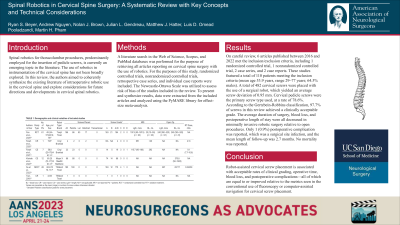Spinal Robotics in Cervical Spine Surgery: A Systematic Review with Key Concepts and Technical Considerations.
Spinal Robotics in Cervical Spine Surgery: A Systematic Review with Key Concepts and Technical Considerations
Friday, April 21, 2023


Nolan J. Brown, MBA
Junior Specialist
UC Irvine Department of Neurosurgery
Santa Clarita, California, United States
ePoster Presenter(s)
Introduction: Spinal robotics for thoracolumbar procedures, predominantly employed for the insertion of pedicle screws, is currently an emerging topic in literature. The use of robotics in instrumentation of the cervical spine has not been broadly explored. This review aims to synthesize in a coherent fashion the existing literature of intraoperative robotic use in the cervical spine and explore considerations for future directions and developments in cervical spinal robotics.
Methods: A literature search in the Web of Science, Scopus and PubMed databases was performed for the purpose of retrieving all articles reporting on cervical spine surgery with the use of robotics. For the purposes of this study, randomized controlled trials, non-randomized controlled trials, retrospective case series and individual case reports were included. Qualitative assessment of included studies was subsequently conducted in accordance with Newcastle-Ottawa Scale criteria.
Results: Upon careful review, 6 articles published between 2016 and 2022 met inclusion/exclusion criteria, including 1 randomized controlled trial, 1 non-randomized controlled trial, 2 case series, and 2 case reports. These studies featured a total of 110 patients meeting inclusion criteria (mean age 53.9 years, range 29 – 77 years; 64.5% males). A total of 482 cervical screws were placed with the use of a surgical robot, which yielded an average screw deviation of 0.95 mm. According to the Gertzbein and Robbins classification, 97.7% of screws in this review achieved a clinically acceptable grade. Average duration of surgery, blood loss, and postoperative length of stay were all decreased in minimally invasive robotic surgery relative to open procedures. Postoperative complication rate was 0.9% with a mean follow-up of 2.7 months.
Conclusion : Robotic-assisted cervical screw placement is associated with acceptable rates of clinical grading, operative time, blood loss, and postoperative complications - all of which are equal to or improved relative to the metrics seen in conventional cervical screw placement.
Methods: A literature search in the Web of Science, Scopus and PubMed databases was performed for the purpose of retrieving all articles reporting on cervical spine surgery with the use of robotics. For the purposes of this study, randomized controlled trials, non-randomized controlled trials, retrospective case series and individual case reports were included. Qualitative assessment of included studies was subsequently conducted in accordance with Newcastle-Ottawa Scale criteria.
Results: Upon careful review, 6 articles published between 2016 and 2022 met inclusion/exclusion criteria, including 1 randomized controlled trial, 1 non-randomized controlled trial, 2 case series, and 2 case reports. These studies featured a total of 110 patients meeting inclusion criteria (mean age 53.9 years, range 29 – 77 years; 64.5% males). A total of 482 cervical screws were placed with the use of a surgical robot, which yielded an average screw deviation of 0.95 mm. According to the Gertzbein and Robbins classification, 97.7% of screws in this review achieved a clinically acceptable grade. Average duration of surgery, blood loss, and postoperative length of stay were all decreased in minimally invasive robotic surgery relative to open procedures. Postoperative complication rate was 0.9% with a mean follow-up of 2.7 months.
Conclusion : Robotic-assisted cervical screw placement is associated with acceptable rates of clinical grading, operative time, blood loss, and postoperative complications - all of which are equal to or improved relative to the metrics seen in conventional cervical screw placement.
